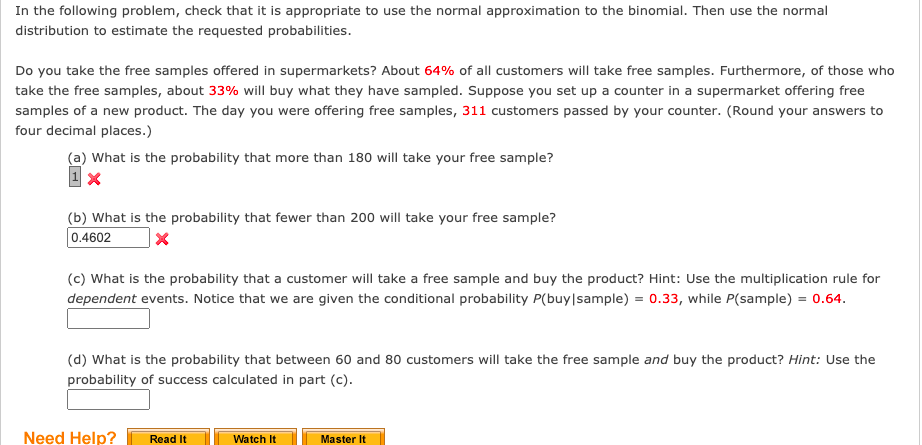In the following problem, check that it is appropriate to use the normal approximation to the binomial. Then use the normal distribution to estimate the requested probabilities. Do you take the free samples offered in supermarkets? About 64% of all customers will take free samples. Furthermore, of those who take the free samples, about 33% will buy what they have sampled. Suppose you set up a counter in a supermarket offering free samples of a new product. The day you were offering free samples, 311 customers passed by your counter. (Round your answers to four decimal places.) (a) What is the probability that more than 180 will take your free sample? (b) What is the probability that fewer than 200 will take your free sample? 0.4602 (c) What is the probability that a customer will take a free sample and buy the product? Hint: Use the multiplication rule for dependent events. Notice that we are given the conditional probability P(buy|sample) = 0.33, while P(sample) = 0.64. (d) What is the probability that between 60 and 80 customers will take the free sample and buy the product? Hint: Use the probability of success calculated in part (c).
Unitary Method
The word “unitary” comes from the word “unit”, which means a single and complete entity. In this method, we find the value of a unit product from the given number of products, and then we solve for the other number of products.
Speed, Time, and Distance
Imagine you and 3 of your friends are planning to go to the playground at 6 in the evening. Your house is one mile away from the playground and one of your friends named Jim must start at 5 pm to reach the playground by walk. The other two friends are 3 miles away.
Profit and Loss
The amount earned or lost on the sale of one or more items is referred to as the profit or loss on that item.
Units and Measurements
Measurements and comparisons are the foundation of science and engineering. We, therefore, need rules that tell us how things are measured and compared. For these measurements and comparisons, we perform certain experiments, and we will need the experiments to set up the devices.
How would you figure out the answer for this?

Since both and are greater than 10, hence normal approximation can be used.
a) Let X be the random variable which denote the number of customer that is take free samples.
The required probability is
Trending now
This is a popular solution!
Step by step
Solved in 2 steps


